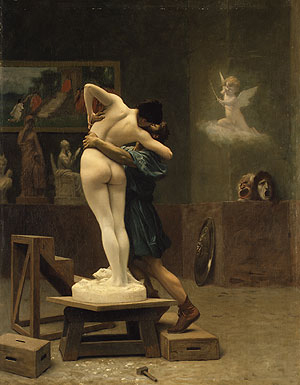| Search Art Prints | ||||||||||||||||||||
| Search Artists | ||||||||||||||||||||

|
||||||||||||||||||||
|
|
|||||||||||||||||||

Pygmalion and Galatea

|
Pygmalion and Galatea is one of Jean-Leon Gerome’s most brilliant masterpieces of the 19th century. It was painted approximately in 1890. In his painting, Gérôme depicts the Greek legend of Pygmalion, a brash young sculptor and Galatea, a carved statue (carved by his own hand) of his ideal woman, embodying every feminine grace and virtue.
The legend has it that Pygmalion labored with all of his skill, rounding here, smoothing there, until he had fashioned the most exquisite figure ever conceived by art. So exquisite indeed was his creation that Pygmalion fell passionately in love with the statue, and could be seen in his studio, kissing and caressing the statue. But soon, Pygmalion became desperately unhappy, for the lifeless statue could not respond to his desires. As it turns out, Venus took pity on Pygmalion and brought his statue to life, and he and Galatea embraced and married with the goddess’s blessing. It was this scene and theme that Gérôme took and drew in his painting; the moment when Galatea awoke from being stone cold and the artist as the creator of life.
Jean-Leon Gérôme was himself a sculptor, which probably had some influence on the subject matter. His interest and passion towards the painting Pygmalion and Galatea was evident. Gérôme depicted the same scene from two focal points, the front and the back of the scene. If you look carefully, however, there are slight differences between the two versions. But in both, Gérôme depicts the moment when Galatea embraces Pygmalion. In the background, a cupid appears, ready to throw an arrow.
The transition from cold stone to living flesh is in its own way strange and surreal. In the same year, Gérôme produced a statue of Pygmalion and Galatea. A statue of a statue…that is ironic!











